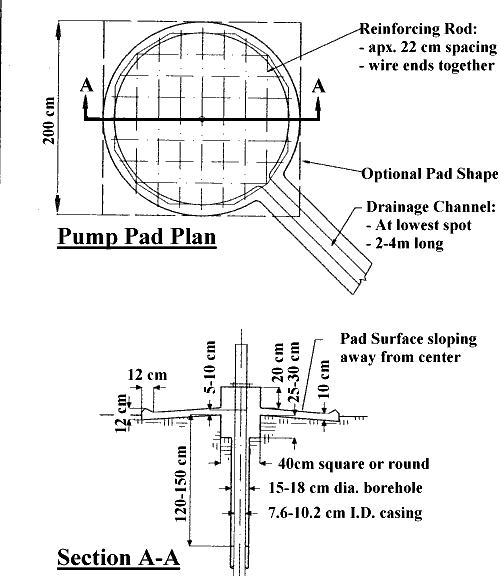
Section 12
Handpump Pad Construction
Handpump Pad Purpose:The purpose of a handpump cement pad (see Figure 16) is to prevent contaminated surface water from entering the well and to prevent the area around the well from becoming muddy and unsanitary so that water buckets stay clean and users of the pump stay dry. |
Design pads to extend 60 cm (2 ft) in all directions past the outer limit of the excavation. Since drilled wells have only a 15 cm (6 inch) annular space, a 60 x 60 cm (2 x 2 ft) pad can provide sufficient sanitary protection. However, many dug wells have annular spaces of 3 m (10 ft) or more. Since it is impractical to fill all the space between the well tiles and the walls of the excavation with cement grout, the concrete pad is essential to ensuring that contaminated water does not enter the well. Therefore, if a 2 m (6 ft) diameter hole is excavated to construct a well, a 3 m (10 ft) diameter pad is required to protect water quality within the well.
Follow the steps described below to design & build a handpump pad:
| 1) Decide on the size and shape of your pad. It should be at least 2 meters by 2 meters square and 10 cm thick (see Figure 16). If the pad is to be this small, add a concrete rectangle on the side of the pump handle so that the person pumping will have firm footing. |
| 2) If appropriate, link the pad to a drainage channel that leads to a garden or animal watering area. Locate watering troughs at least 30 meters away and separated from the well by a substantial barrier to keep animals away from the well. |
| 3) Calculate cement volume to make pad (1:2:4 ratio) (Appendix J). |
Figure 16: Cement Pad Configuration

4) Ensure that the edge of your pad is excavated to extend down 1 foot into undisturbed soil. This prevents water from eroding underneath the pad over time.
| 5) Shape pad edges by centering wooden forms around the well casing. Lay out a grid of steel reinforcing bars, tie them together and raise them several centimeters off the ground (see Appendix J). Alternatively, shape pad edges using concrete blocks which are left in-place after concrete is poured. However, concrete blocks are often made with too little cement resulting in the pad edges quickly disintegrating. To minimize these problems, make your own cement-rich blocks and place concrete inside block holes and over the top & sides of the blocks. |
6) Pour the concrete into the forms, ensuring that the pad has a slight slope from the centre outward to drain water away.
![]()